Strategic Assumptions and Robust Strategy Formulation in New Zealand
VerifiedAdded on 2022/10/15
|14
|3716
|14
Report
AI Summary
This report analyzes the critical role of strategic assumptions in formulating a robust business strategy, specifically within the context of the food industry in New Zealand. The report begins by defining strategic assumptions and their significance, emphasizing the need for grounded and validated assumptions in strategic planning. It then delves into four key areas: macro-environmental forces (analyzed using PEST analysis), market dynamics (examined through Porter's Five Forces), consumer requirements, and workforce considerations. The PEST analysis explores political, economic, socio-cultural, and technological factors influencing the industry, highlighting the impact of government regulations, economic conditions, consumer preferences, and technological advancements. The Porter's Five Forces analysis assesses the bargaining power of buyers and suppliers, competitive rivalry, threat of substitutes, and barriers to entry. The report also investigates consumer needs through a survey, revealing preferences for healthy food options and high-quality products. Finally, the report emphasizes the need for effective strategies to maintain competitive advantage and offers insights for management to make informed decisions and create effective business strategies. The report concludes by highlighting the importance of considering the changing dynamics of the food industry and adapting strategies accordingly.
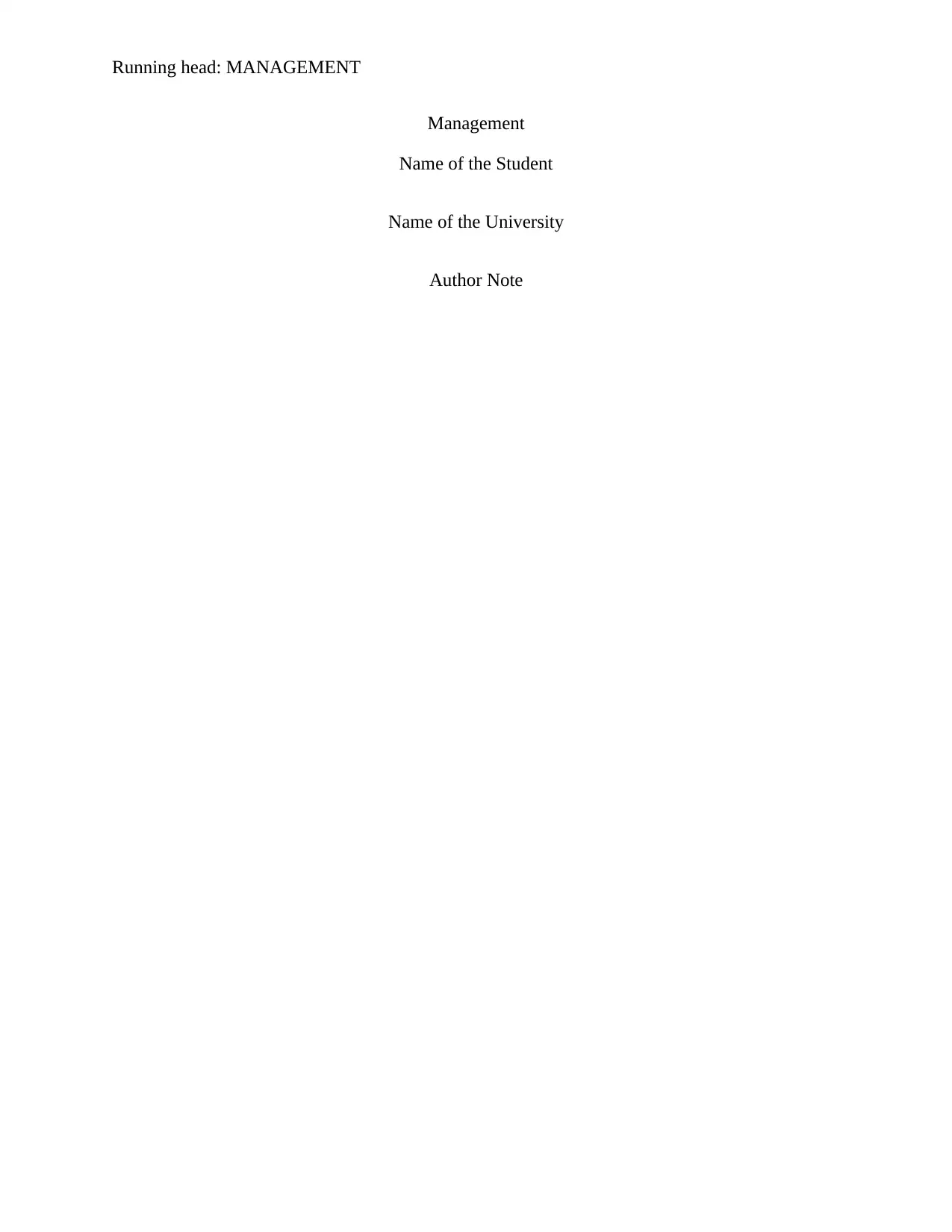
Running head: MANAGEMENT
Management
Name of the Student
Name of the University
Author Note
Management
Name of the Student
Name of the University
Author Note
Paraphrase This Document
Need a fresh take? Get an instant paraphrase of this document with our AI Paraphraser
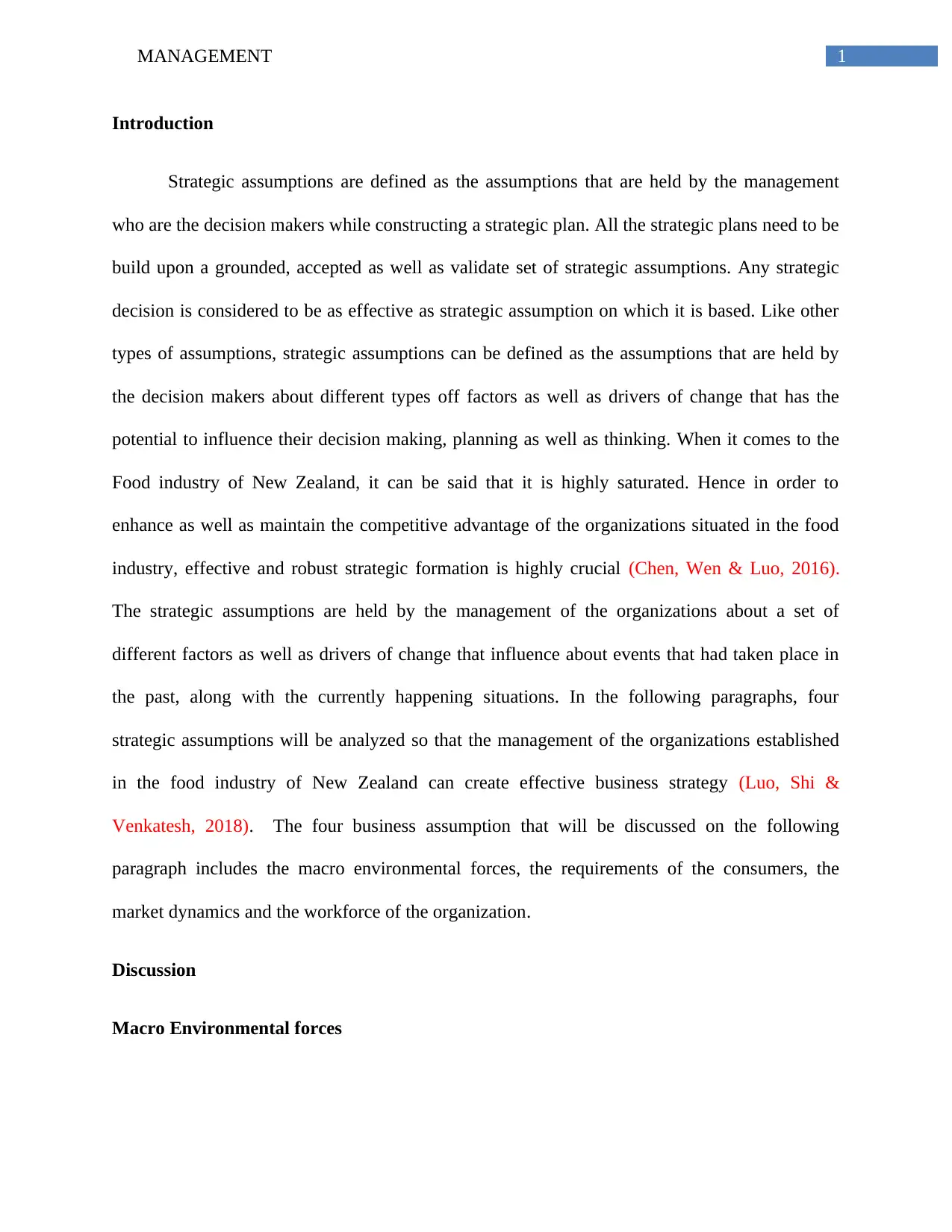
1MANAGEMENT
Introduction
Strategic assumptions are defined as the assumptions that are held by the management
who are the decision makers while constructing a strategic plan. All the strategic plans need to be
build upon a grounded, accepted as well as validate set of strategic assumptions. Any strategic
decision is considered to be as effective as strategic assumption on which it is based. Like other
types of assumptions, strategic assumptions can be defined as the assumptions that are held by
the decision makers about different types off factors as well as drivers of change that has the
potential to influence their decision making, planning as well as thinking. When it comes to the
Food industry of New Zealand, it can be said that it is highly saturated. Hence in order to
enhance as well as maintain the competitive advantage of the organizations situated in the food
industry, effective and robust strategic formation is highly crucial (Chen, Wen & Luo, 2016).
The strategic assumptions are held by the management of the organizations about a set of
different factors as well as drivers of change that influence about events that had taken place in
the past, along with the currently happening situations. In the following paragraphs, four
strategic assumptions will be analyzed so that the management of the organizations established
in the food industry of New Zealand can create effective business strategy (Luo, Shi &
Venkatesh, 2018). The four business assumption that will be discussed on the following
paragraph includes the macro environmental forces, the requirements of the consumers, the
market dynamics and the workforce of the organization.
Discussion
Macro Environmental forces
Introduction
Strategic assumptions are defined as the assumptions that are held by the management
who are the decision makers while constructing a strategic plan. All the strategic plans need to be
build upon a grounded, accepted as well as validate set of strategic assumptions. Any strategic
decision is considered to be as effective as strategic assumption on which it is based. Like other
types of assumptions, strategic assumptions can be defined as the assumptions that are held by
the decision makers about different types off factors as well as drivers of change that has the
potential to influence their decision making, planning as well as thinking. When it comes to the
Food industry of New Zealand, it can be said that it is highly saturated. Hence in order to
enhance as well as maintain the competitive advantage of the organizations situated in the food
industry, effective and robust strategic formation is highly crucial (Chen, Wen & Luo, 2016).
The strategic assumptions are held by the management of the organizations about a set of
different factors as well as drivers of change that influence about events that had taken place in
the past, along with the currently happening situations. In the following paragraphs, four
strategic assumptions will be analyzed so that the management of the organizations established
in the food industry of New Zealand can create effective business strategy (Luo, Shi &
Venkatesh, 2018). The four business assumption that will be discussed on the following
paragraph includes the macro environmental forces, the requirements of the consumers, the
market dynamics and the workforce of the organization.
Discussion
Macro Environmental forces
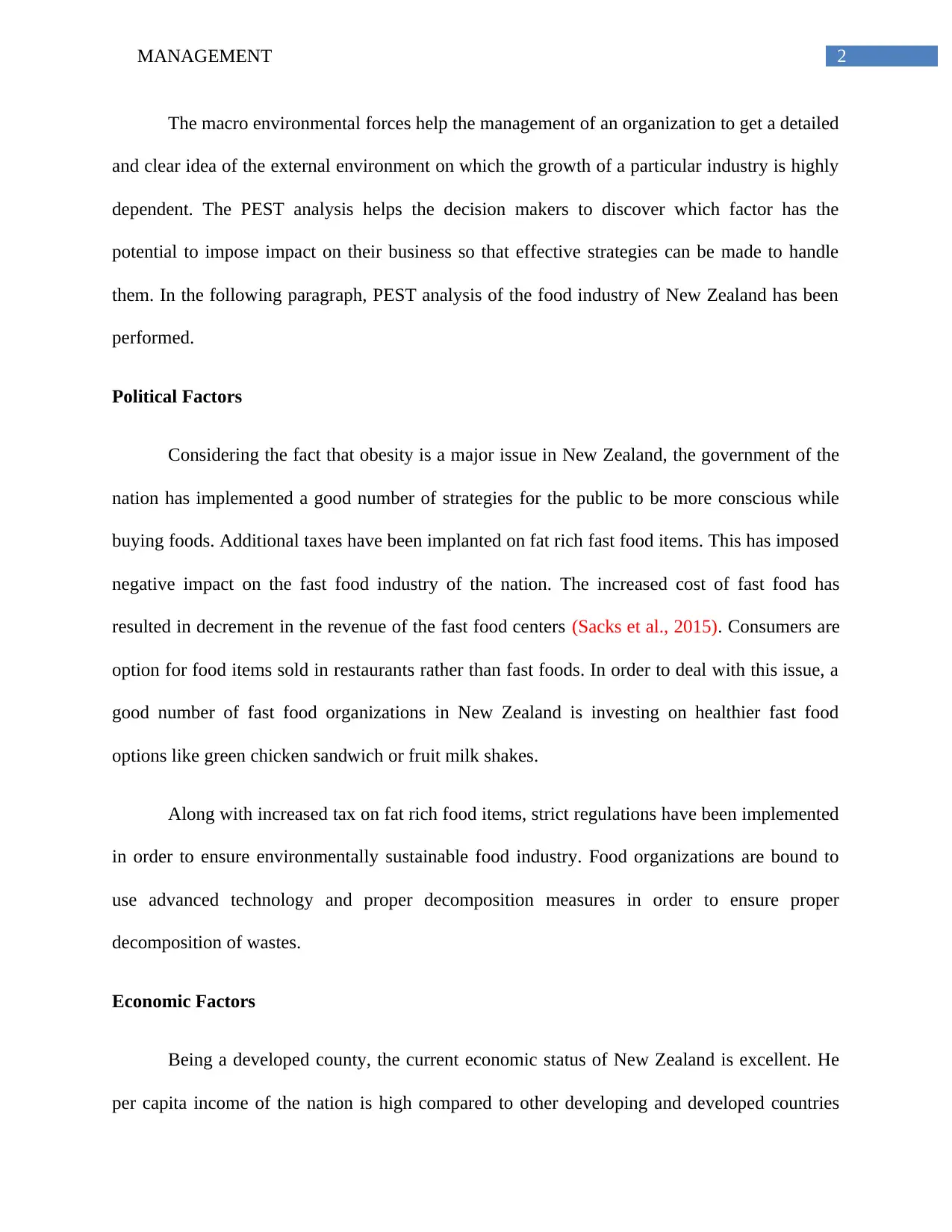
2MANAGEMENT
The macro environmental forces help the management of an organization to get a detailed
and clear idea of the external environment on which the growth of a particular industry is highly
dependent. The PEST analysis helps the decision makers to discover which factor has the
potential to impose impact on their business so that effective strategies can be made to handle
them. In the following paragraph, PEST analysis of the food industry of New Zealand has been
performed.
Political Factors
Considering the fact that obesity is a major issue in New Zealand, the government of the
nation has implemented a good number of strategies for the public to be more conscious while
buying foods. Additional taxes have been implanted on fat rich fast food items. This has imposed
negative impact on the fast food industry of the nation. The increased cost of fast food has
resulted in decrement in the revenue of the fast food centers (Sacks et al., 2015). Consumers are
option for food items sold in restaurants rather than fast foods. In order to deal with this issue, a
good number of fast food organizations in New Zealand is investing on healthier fast food
options like green chicken sandwich or fruit milk shakes.
Along with increased tax on fat rich food items, strict regulations have been implemented
in order to ensure environmentally sustainable food industry. Food organizations are bound to
use advanced technology and proper decomposition measures in order to ensure proper
decomposition of wastes.
Economic Factors
Being a developed county, the current economic status of New Zealand is excellent. He
per capita income of the nation is high compared to other developing and developed countries
The macro environmental forces help the management of an organization to get a detailed
and clear idea of the external environment on which the growth of a particular industry is highly
dependent. The PEST analysis helps the decision makers to discover which factor has the
potential to impose impact on their business so that effective strategies can be made to handle
them. In the following paragraph, PEST analysis of the food industry of New Zealand has been
performed.
Political Factors
Considering the fact that obesity is a major issue in New Zealand, the government of the
nation has implemented a good number of strategies for the public to be more conscious while
buying foods. Additional taxes have been implanted on fat rich fast food items. This has imposed
negative impact on the fast food industry of the nation. The increased cost of fast food has
resulted in decrement in the revenue of the fast food centers (Sacks et al., 2015). Consumers are
option for food items sold in restaurants rather than fast foods. In order to deal with this issue, a
good number of fast food organizations in New Zealand is investing on healthier fast food
options like green chicken sandwich or fruit milk shakes.
Along with increased tax on fat rich food items, strict regulations have been implemented
in order to ensure environmentally sustainable food industry. Food organizations are bound to
use advanced technology and proper decomposition measures in order to ensure proper
decomposition of wastes.
Economic Factors
Being a developed county, the current economic status of New Zealand is excellent. He
per capita income of the nation is high compared to other developing and developed countries
⊘ This is a preview!⊘
Do you want full access?
Subscribe today to unlock all pages.

Trusted by 1+ million students worldwide
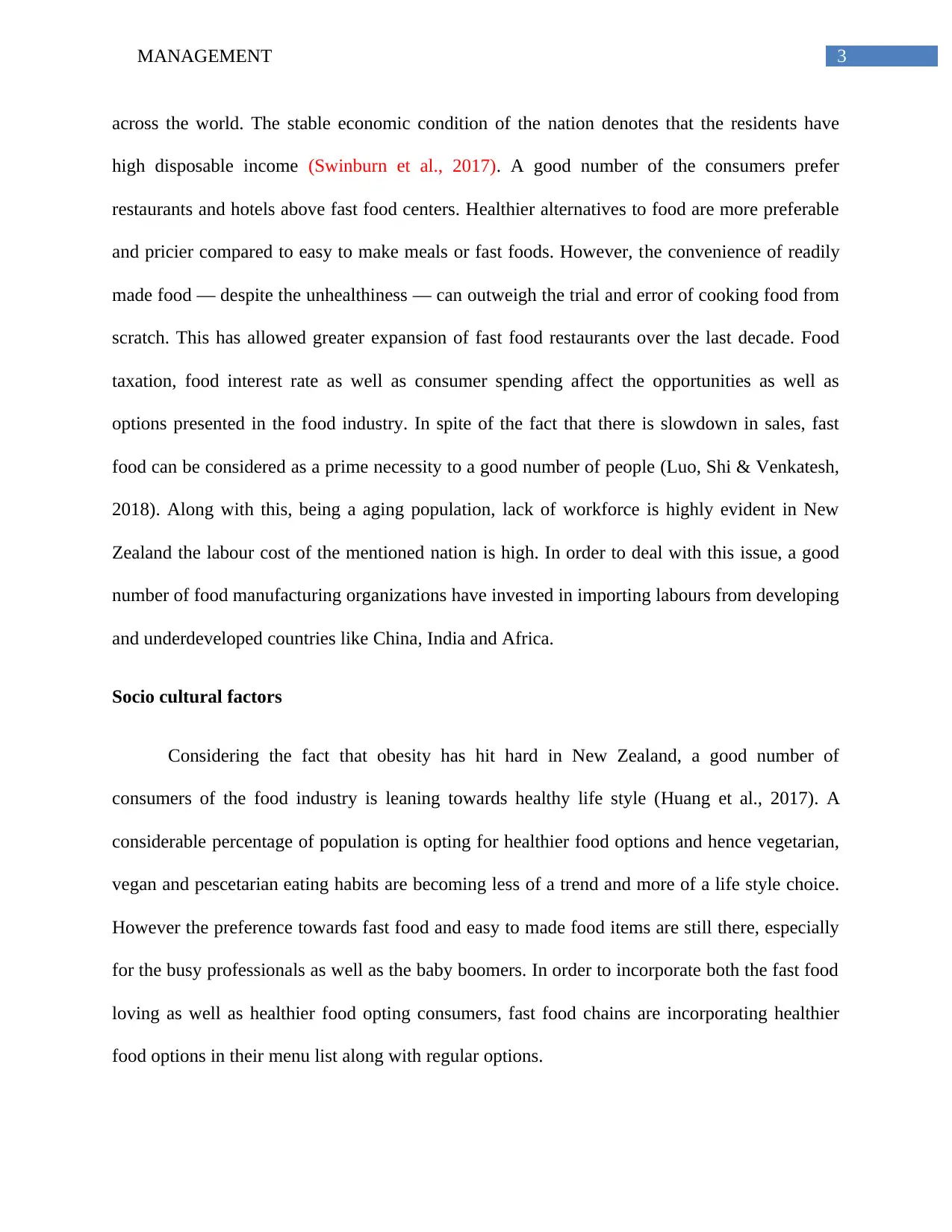
3MANAGEMENT
across the world. The stable economic condition of the nation denotes that the residents have
high disposable income (Swinburn et al., 2017). A good number of the consumers prefer
restaurants and hotels above fast food centers. Healthier alternatives to food are more preferable
and pricier compared to easy to make meals or fast foods. However, the convenience of readily
made food — despite the unhealthiness — can outweigh the trial and error of cooking food from
scratch. This has allowed greater expansion of fast food restaurants over the last decade. Food
taxation, food interest rate as well as consumer spending affect the opportunities as well as
options presented in the food industry. In spite of the fact that there is slowdown in sales, fast
food can be considered as a prime necessity to a good number of people (Luo, Shi & Venkatesh,
2018). Along with this, being a aging population, lack of workforce is highly evident in New
Zealand the labour cost of the mentioned nation is high. In order to deal with this issue, a good
number of food manufacturing organizations have invested in importing labours from developing
and underdeveloped countries like China, India and Africa.
Socio cultural factors
Considering the fact that obesity has hit hard in New Zealand, a good number of
consumers of the food industry is leaning towards healthy life style (Huang et al., 2017). A
considerable percentage of population is opting for healthier food options and hence vegetarian,
vegan and pescetarian eating habits are becoming less of a trend and more of a life style choice.
However the preference towards fast food and easy to made food items are still there, especially
for the busy professionals as well as the baby boomers. In order to incorporate both the fast food
loving as well as healthier food opting consumers, fast food chains are incorporating healthier
food options in their menu list along with regular options.
across the world. The stable economic condition of the nation denotes that the residents have
high disposable income (Swinburn et al., 2017). A good number of the consumers prefer
restaurants and hotels above fast food centers. Healthier alternatives to food are more preferable
and pricier compared to easy to make meals or fast foods. However, the convenience of readily
made food — despite the unhealthiness — can outweigh the trial and error of cooking food from
scratch. This has allowed greater expansion of fast food restaurants over the last decade. Food
taxation, food interest rate as well as consumer spending affect the opportunities as well as
options presented in the food industry. In spite of the fact that there is slowdown in sales, fast
food can be considered as a prime necessity to a good number of people (Luo, Shi & Venkatesh,
2018). Along with this, being a aging population, lack of workforce is highly evident in New
Zealand the labour cost of the mentioned nation is high. In order to deal with this issue, a good
number of food manufacturing organizations have invested in importing labours from developing
and underdeveloped countries like China, India and Africa.
Socio cultural factors
Considering the fact that obesity has hit hard in New Zealand, a good number of
consumers of the food industry is leaning towards healthy life style (Huang et al., 2017). A
considerable percentage of population is opting for healthier food options and hence vegetarian,
vegan and pescetarian eating habits are becoming less of a trend and more of a life style choice.
However the preference towards fast food and easy to made food items are still there, especially
for the busy professionals as well as the baby boomers. In order to incorporate both the fast food
loving as well as healthier food opting consumers, fast food chains are incorporating healthier
food options in their menu list along with regular options.
Paraphrase This Document
Need a fresh take? Get an instant paraphrase of this document with our AI Paraphraser
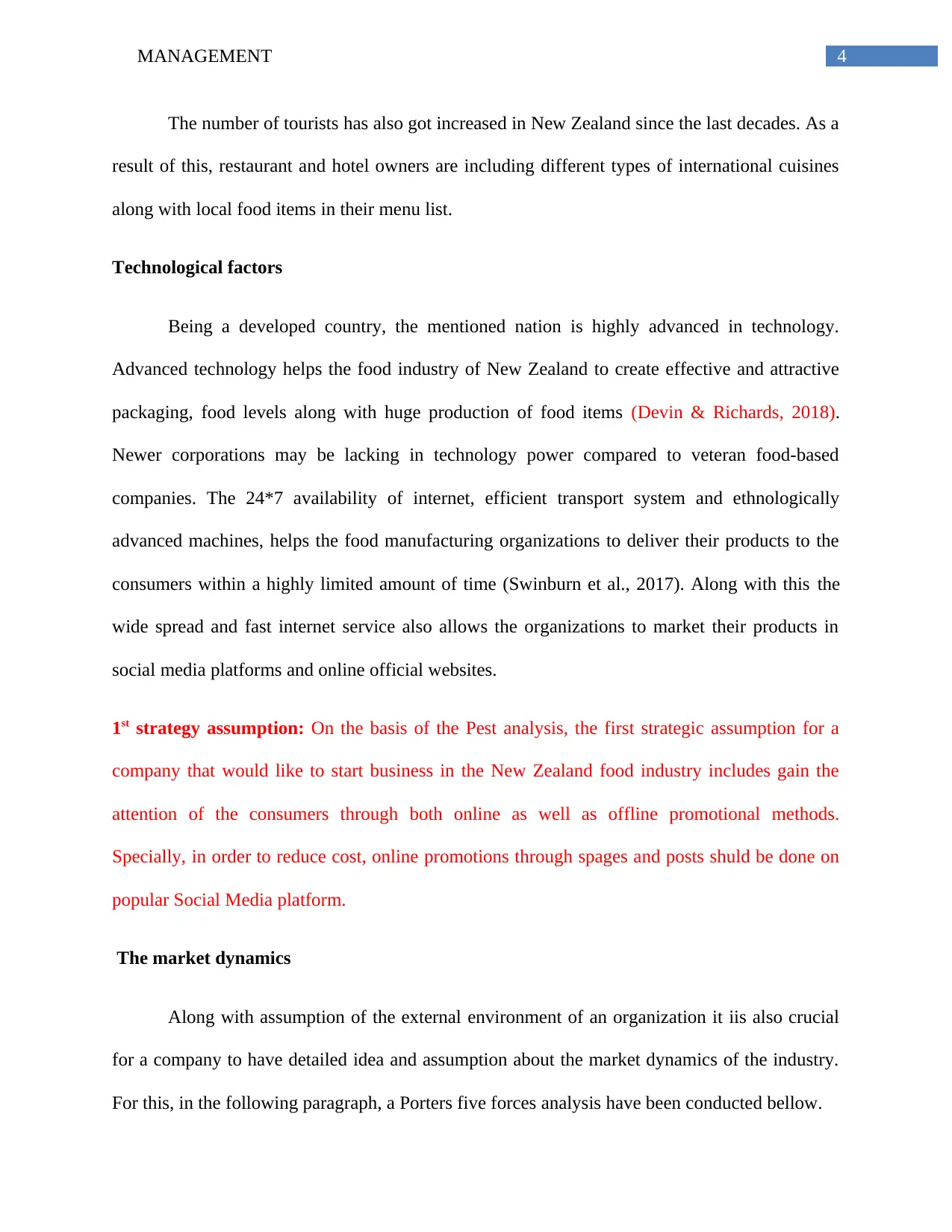
4MANAGEMENT
The number of tourists has also got increased in New Zealand since the last decades. As a
result of this, restaurant and hotel owners are including different types of international cuisines
along with local food items in their menu list.
Technological factors
Being a developed country, the mentioned nation is highly advanced in technology.
Advanced technology helps the food industry of New Zealand to create effective and attractive
packaging, food levels along with huge production of food items (Devin & Richards, 2018).
Newer corporations may be lacking in technology power compared to veteran food-based
companies. The 24*7 availability of internet, efficient transport system and ethnologically
advanced machines, helps the food manufacturing organizations to deliver their products to the
consumers within a highly limited amount of time (Swinburn et al., 2017). Along with this the
wide spread and fast internet service also allows the organizations to market their products in
social media platforms and online official websites.
1st strategy assumption: On the basis of the Pest analysis, the first strategic assumption for a
company that would like to start business in the New Zealand food industry includes gain the
attention of the consumers through both online as well as offline promotional methods.
Specially, in order to reduce cost, online promotions through spages and posts shuld be done on
popular Social Media platform.
The market dynamics
Along with assumption of the external environment of an organization it iis also crucial
for a company to have detailed idea and assumption about the market dynamics of the industry.
For this, in the following paragraph, a Porters five forces analysis have been conducted bellow.
The number of tourists has also got increased in New Zealand since the last decades. As a
result of this, restaurant and hotel owners are including different types of international cuisines
along with local food items in their menu list.
Technological factors
Being a developed country, the mentioned nation is highly advanced in technology.
Advanced technology helps the food industry of New Zealand to create effective and attractive
packaging, food levels along with huge production of food items (Devin & Richards, 2018).
Newer corporations may be lacking in technology power compared to veteran food-based
companies. The 24*7 availability of internet, efficient transport system and ethnologically
advanced machines, helps the food manufacturing organizations to deliver their products to the
consumers within a highly limited amount of time (Swinburn et al., 2017). Along with this the
wide spread and fast internet service also allows the organizations to market their products in
social media platforms and online official websites.
1st strategy assumption: On the basis of the Pest analysis, the first strategic assumption for a
company that would like to start business in the New Zealand food industry includes gain the
attention of the consumers through both online as well as offline promotional methods.
Specially, in order to reduce cost, online promotions through spages and posts shuld be done on
popular Social Media platform.
The market dynamics
Along with assumption of the external environment of an organization it iis also crucial
for a company to have detailed idea and assumption about the market dynamics of the industry.
For this, in the following paragraph, a Porters five forces analysis have been conducted bellow.
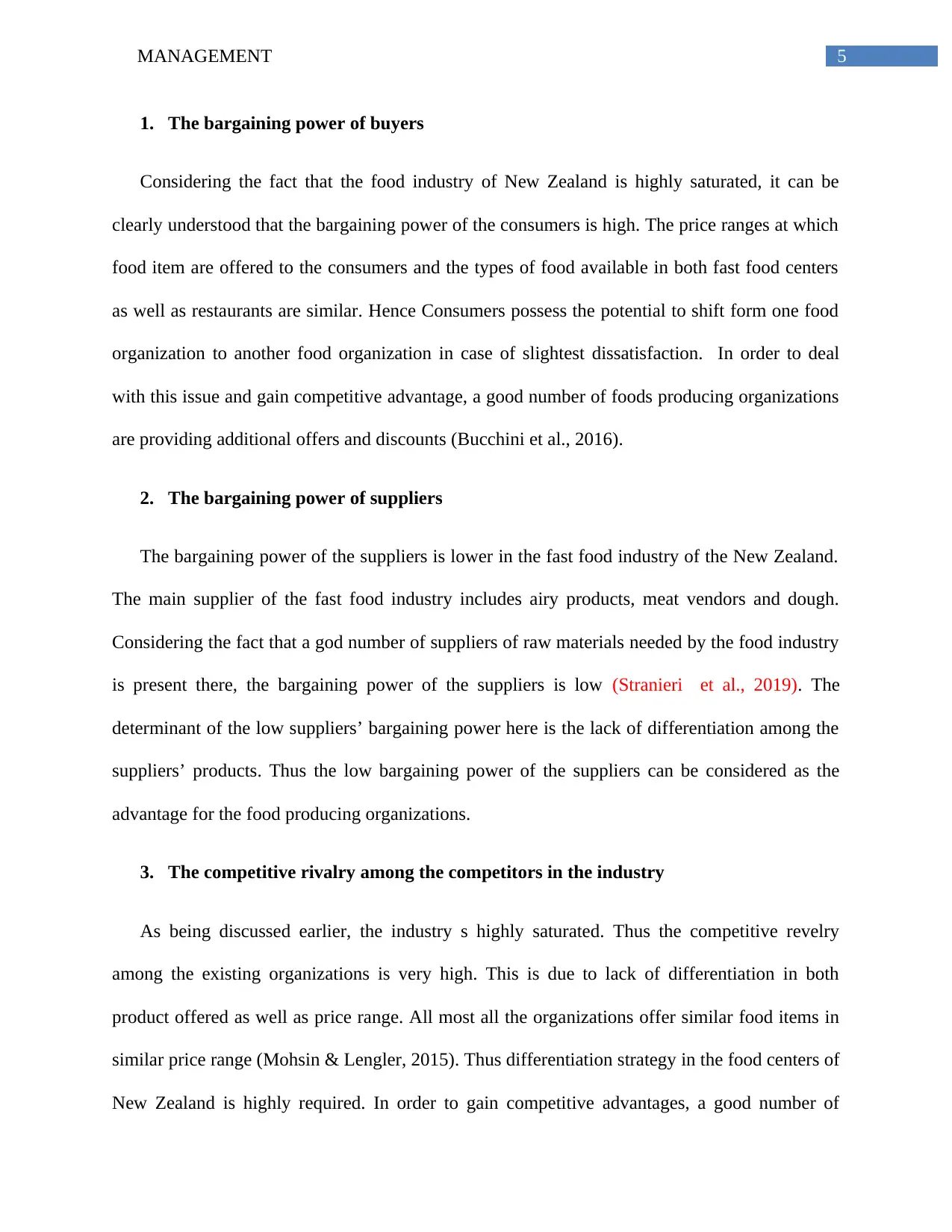
5MANAGEMENT
1. The bargaining power of buyers
Considering the fact that the food industry of New Zealand is highly saturated, it can be
clearly understood that the bargaining power of the consumers is high. The price ranges at which
food item are offered to the consumers and the types of food available in both fast food centers
as well as restaurants are similar. Hence Consumers possess the potential to shift form one food
organization to another food organization in case of slightest dissatisfaction. In order to deal
with this issue and gain competitive advantage, a good number of foods producing organizations
are providing additional offers and discounts (Bucchini et al., 2016).
2. The bargaining power of suppliers
The bargaining power of the suppliers is lower in the fast food industry of the New Zealand.
The main supplier of the fast food industry includes airy products, meat vendors and dough.
Considering the fact that a god number of suppliers of raw materials needed by the food industry
is present there, the bargaining power of the suppliers is low (Stranieri et al., 2019). The
determinant of the low suppliers’ bargaining power here is the lack of differentiation among the
suppliers’ products. Thus the low bargaining power of the suppliers can be considered as the
advantage for the food producing organizations.
3. The competitive rivalry among the competitors in the industry
As being discussed earlier, the industry s highly saturated. Thus the competitive revelry
among the existing organizations is very high. This is due to lack of differentiation in both
product offered as well as price range. All most all the organizations offer similar food items in
similar price range (Mohsin & Lengler, 2015). Thus differentiation strategy in the food centers of
New Zealand is highly required. In order to gain competitive advantages, a good number of
1. The bargaining power of buyers
Considering the fact that the food industry of New Zealand is highly saturated, it can be
clearly understood that the bargaining power of the consumers is high. The price ranges at which
food item are offered to the consumers and the types of food available in both fast food centers
as well as restaurants are similar. Hence Consumers possess the potential to shift form one food
organization to another food organization in case of slightest dissatisfaction. In order to deal
with this issue and gain competitive advantage, a good number of foods producing organizations
are providing additional offers and discounts (Bucchini et al., 2016).
2. The bargaining power of suppliers
The bargaining power of the suppliers is lower in the fast food industry of the New Zealand.
The main supplier of the fast food industry includes airy products, meat vendors and dough.
Considering the fact that a god number of suppliers of raw materials needed by the food industry
is present there, the bargaining power of the suppliers is low (Stranieri et al., 2019). The
determinant of the low suppliers’ bargaining power here is the lack of differentiation among the
suppliers’ products. Thus the low bargaining power of the suppliers can be considered as the
advantage for the food producing organizations.
3. The competitive rivalry among the competitors in the industry
As being discussed earlier, the industry s highly saturated. Thus the competitive revelry
among the existing organizations is very high. This is due to lack of differentiation in both
product offered as well as price range. All most all the organizations offer similar food items in
similar price range (Mohsin & Lengler, 2015). Thus differentiation strategy in the food centers of
New Zealand is highly required. In order to gain competitive advantages, a good number of
⊘ This is a preview!⊘
Do you want full access?
Subscribe today to unlock all pages.

Trusted by 1+ million students worldwide

6MANAGEMENT
organizations, offers frequent discounts and offers to the consumers. Along with this, for
enhancing the consumer base, healthier food choices are being incorporated in the menu list of
the food organizations in New Zealand.
4. The threat of substitute products
The threat of substitute product is low in for the food industry. The chief substitutes of
the food industry include meal replacements. However substitute of fast food includes restaurant
cuisines and vise Vera. However since the food supplements are only taken by very limited
amount of consumers, it can be said that the overall risk of from substitute products is low.
The threat of new entrants, or barriers to entry into the industry
The threat of new entrance in the fast food industry of New Zealand is moderate. This is
because in order to start a new business in the food industry, the investment cost is high. This
high investment cost makes it difficult for new entrepreneur to start business in them mentioned
field. Along with this the highly competition makes it more difficult to get successfully
established in the market (Kasture et al., 2019). However, considering the fact that the
government has loosens the policies and procedures in order to attract more international food
chains in New Zealand, already established food chains are entering the market. Hence the threat
of new entrance I moderate in the food industry New Zealand.
2nd strategic assumption: On the basis of the Porters five analysis, the new restaurant should
offer the consumers with highly cost effective food items and frequently provide discounts
without hampering the quality of the food items.
organizations, offers frequent discounts and offers to the consumers. Along with this, for
enhancing the consumer base, healthier food choices are being incorporated in the menu list of
the food organizations in New Zealand.
4. The threat of substitute products
The threat of substitute product is low in for the food industry. The chief substitutes of
the food industry include meal replacements. However substitute of fast food includes restaurant
cuisines and vise Vera. However since the food supplements are only taken by very limited
amount of consumers, it can be said that the overall risk of from substitute products is low.
The threat of new entrants, or barriers to entry into the industry
The threat of new entrance in the fast food industry of New Zealand is moderate. This is
because in order to start a new business in the food industry, the investment cost is high. This
high investment cost makes it difficult for new entrepreneur to start business in them mentioned
field. Along with this the highly competition makes it more difficult to get successfully
established in the market (Kasture et al., 2019). However, considering the fact that the
government has loosens the policies and procedures in order to attract more international food
chains in New Zealand, already established food chains are entering the market. Hence the threat
of new entrance I moderate in the food industry New Zealand.
2nd strategic assumption: On the basis of the Porters five analysis, the new restaurant should
offer the consumers with highly cost effective food items and frequently provide discounts
without hampering the quality of the food items.
Paraphrase This Document
Need a fresh take? Get an instant paraphrase of this document with our AI Paraphraser

7MANAGEMENT
The needs of customers
The third strategic assumption that is highly crucial for the decision makers of the
organizations established in the food industry of New Zealand is having clear idea of the
requirements of the consumers. In order to gain a vivid idea of the needs of the consumer, a
survey has been conducted in one of the highly popular restaurant of New Zealand. From the
survey, it has been found that while 67 percent of the consumers prefers healthy food cuisines
over high Calorie food cuisines, rest o the consumers provides priority to the taste of the food
item rather than the amount of calories it posses. 23 percent of the participants who prioritized
the value of the food items over the taste were of the age range 16 to 28 years. The rest 77
percent population who had given priority to nutrient rich and low calorie food were of the age
range 58 to 70 years (El Baz et al., 2016).
According to researchers, being a country with aging population a good number of the
population is getting inclined towards heather food habits. Thus healthier food is one of the chief
necessities of the consumers (Mohsin & Lengler, 2015).
Another major necessity of the consumers includes high quality of the food item. Considering
the fact that the disposable income of the consumers is high, it can be clearly that majority of the
consumers opts for high quality food within a justified price range (Shnayder,Van Rijnsoever &
Hekkert,2016). Hence in order to enhance the consumer base, the organizations of food industry
must use superior quality of raw materials. Along with regular monitoring of the supply chain is
highly required.
The third requirement of the consumer is higher availability of home delivery.
Considering the fact that population of New Zealand is aging, more than 56 percent of the
The needs of customers
The third strategic assumption that is highly crucial for the decision makers of the
organizations established in the food industry of New Zealand is having clear idea of the
requirements of the consumers. In order to gain a vivid idea of the needs of the consumer, a
survey has been conducted in one of the highly popular restaurant of New Zealand. From the
survey, it has been found that while 67 percent of the consumers prefers healthy food cuisines
over high Calorie food cuisines, rest o the consumers provides priority to the taste of the food
item rather than the amount of calories it posses. 23 percent of the participants who prioritized
the value of the food items over the taste were of the age range 16 to 28 years. The rest 77
percent population who had given priority to nutrient rich and low calorie food were of the age
range 58 to 70 years (El Baz et al., 2016).
According to researchers, being a country with aging population a good number of the
population is getting inclined towards heather food habits. Thus healthier food is one of the chief
necessities of the consumers (Mohsin & Lengler, 2015).
Another major necessity of the consumers includes high quality of the food item. Considering
the fact that the disposable income of the consumers is high, it can be clearly that majority of the
consumers opts for high quality food within a justified price range (Shnayder,Van Rijnsoever &
Hekkert,2016). Hence in order to enhance the consumer base, the organizations of food industry
must use superior quality of raw materials. Along with regular monitoring of the supply chain is
highly required.
The third requirement of the consumer is higher availability of home delivery.
Considering the fact that population of New Zealand is aging, more than 56 percent of the
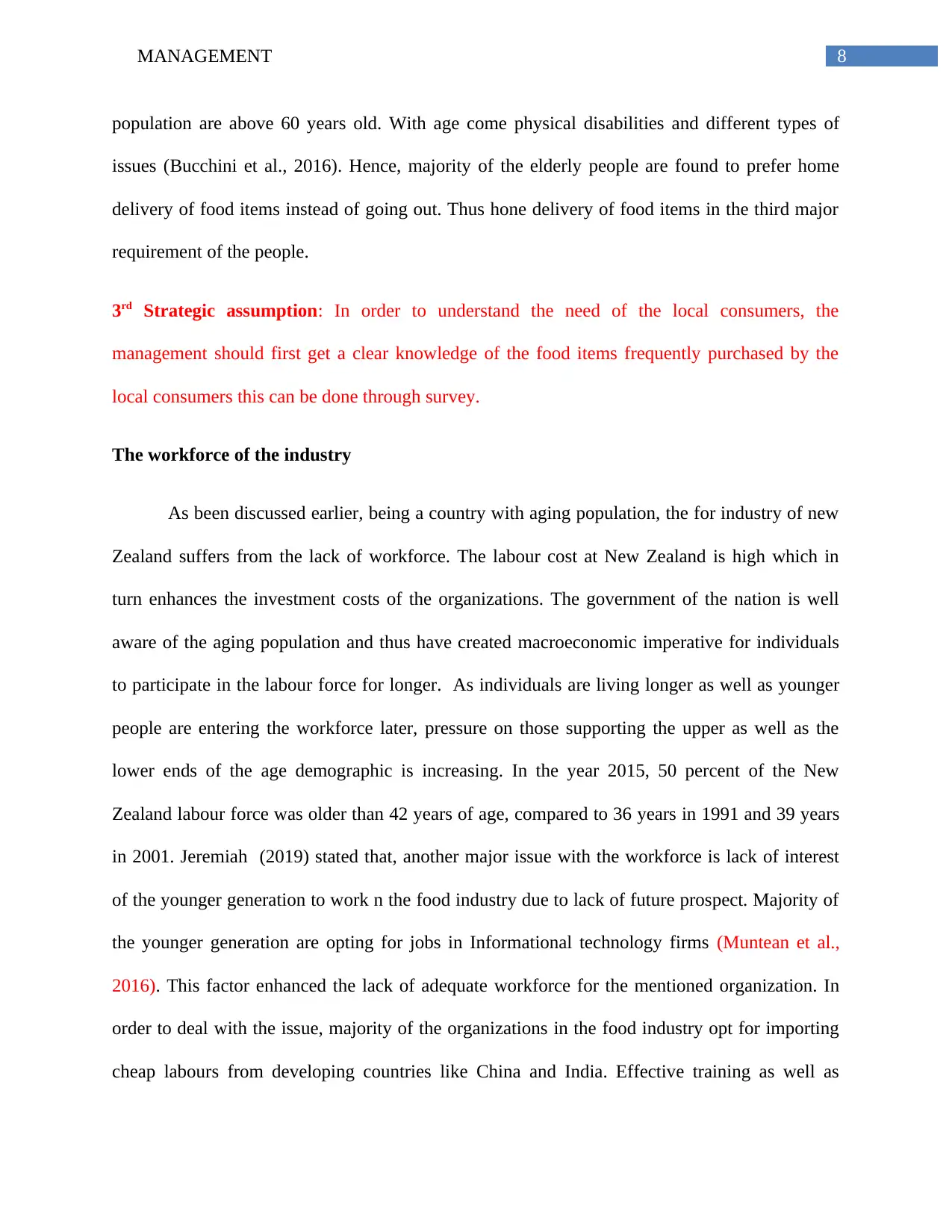
8MANAGEMENT
population are above 60 years old. With age come physical disabilities and different types of
issues (Bucchini et al., 2016). Hence, majority of the elderly people are found to prefer home
delivery of food items instead of going out. Thus hone delivery of food items in the third major
requirement of the people.
3rd Strategic assumption: In order to understand the need of the local consumers, the
management should first get a clear knowledge of the food items frequently purchased by the
local consumers this can be done through survey.
The workforce of the industry
As been discussed earlier, being a country with aging population, the for industry of new
Zealand suffers from the lack of workforce. The labour cost at New Zealand is high which in
turn enhances the investment costs of the organizations. The government of the nation is well
aware of the aging population and thus have created macroeconomic imperative for individuals
to participate in the labour force for longer. As individuals are living longer as well as younger
people are entering the workforce later, pressure on those supporting the upper as well as the
lower ends of the age demographic is increasing. In the year 2015, 50 percent of the New
Zealand labour force was older than 42 years of age, compared to 36 years in 1991 and 39 years
in 2001. Jeremiah (2019) stated that, another major issue with the workforce is lack of interest
of the younger generation to work n the food industry due to lack of future prospect. Majority of
the younger generation are opting for jobs in Informational technology firms (Muntean et al.,
2016). This factor enhanced the lack of adequate workforce for the mentioned organization. In
order to deal with the issue, majority of the organizations in the food industry opt for importing
cheap labours from developing countries like China and India. Effective training as well as
population are above 60 years old. With age come physical disabilities and different types of
issues (Bucchini et al., 2016). Hence, majority of the elderly people are found to prefer home
delivery of food items instead of going out. Thus hone delivery of food items in the third major
requirement of the people.
3rd Strategic assumption: In order to understand the need of the local consumers, the
management should first get a clear knowledge of the food items frequently purchased by the
local consumers this can be done through survey.
The workforce of the industry
As been discussed earlier, being a country with aging population, the for industry of new
Zealand suffers from the lack of workforce. The labour cost at New Zealand is high which in
turn enhances the investment costs of the organizations. The government of the nation is well
aware of the aging population and thus have created macroeconomic imperative for individuals
to participate in the labour force for longer. As individuals are living longer as well as younger
people are entering the workforce later, pressure on those supporting the upper as well as the
lower ends of the age demographic is increasing. In the year 2015, 50 percent of the New
Zealand labour force was older than 42 years of age, compared to 36 years in 1991 and 39 years
in 2001. Jeremiah (2019) stated that, another major issue with the workforce is lack of interest
of the younger generation to work n the food industry due to lack of future prospect. Majority of
the younger generation are opting for jobs in Informational technology firms (Muntean et al.,
2016). This factor enhanced the lack of adequate workforce for the mentioned organization. In
order to deal with the issue, majority of the organizations in the food industry opt for importing
cheap labours from developing countries like China and India. Effective training as well as
⊘ This is a preview!⊘
Do you want full access?
Subscribe today to unlock all pages.

Trusted by 1+ million students worldwide
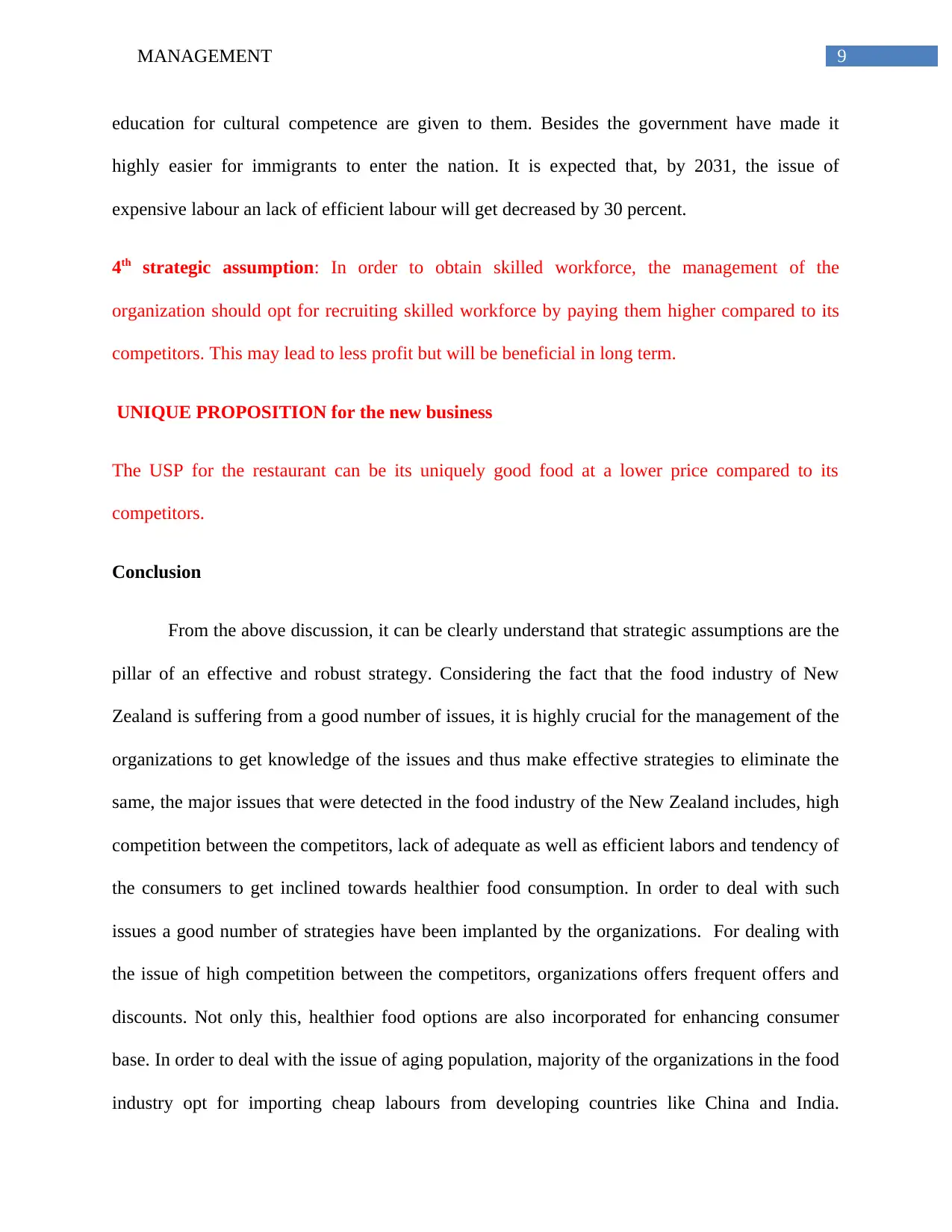
9MANAGEMENT
education for cultural competence are given to them. Besides the government have made it
highly easier for immigrants to enter the nation. It is expected that, by 2031, the issue of
expensive labour an lack of efficient labour will get decreased by 30 percent.
4th strategic assumption: In order to obtain skilled workforce, the management of the
organization should opt for recruiting skilled workforce by paying them higher compared to its
competitors. This may lead to less profit but will be beneficial in long term.
UNIQUE PROPOSITION for the new business
The USP for the restaurant can be its uniquely good food at a lower price compared to its
competitors.
Conclusion
From the above discussion, it can be clearly understand that strategic assumptions are the
pillar of an effective and robust strategy. Considering the fact that the food industry of New
Zealand is suffering from a good number of issues, it is highly crucial for the management of the
organizations to get knowledge of the issues and thus make effective strategies to eliminate the
same, the major issues that were detected in the food industry of the New Zealand includes, high
competition between the competitors, lack of adequate as well as efficient labors and tendency of
the consumers to get inclined towards healthier food consumption. In order to deal with such
issues a good number of strategies have been implanted by the organizations. For dealing with
the issue of high competition between the competitors, organizations offers frequent offers and
discounts. Not only this, healthier food options are also incorporated for enhancing consumer
base. In order to deal with the issue of aging population, majority of the organizations in the food
industry opt for importing cheap labours from developing countries like China and India.
education for cultural competence are given to them. Besides the government have made it
highly easier for immigrants to enter the nation. It is expected that, by 2031, the issue of
expensive labour an lack of efficient labour will get decreased by 30 percent.
4th strategic assumption: In order to obtain skilled workforce, the management of the
organization should opt for recruiting skilled workforce by paying them higher compared to its
competitors. This may lead to less profit but will be beneficial in long term.
UNIQUE PROPOSITION for the new business
The USP for the restaurant can be its uniquely good food at a lower price compared to its
competitors.
Conclusion
From the above discussion, it can be clearly understand that strategic assumptions are the
pillar of an effective and robust strategy. Considering the fact that the food industry of New
Zealand is suffering from a good number of issues, it is highly crucial for the management of the
organizations to get knowledge of the issues and thus make effective strategies to eliminate the
same, the major issues that were detected in the food industry of the New Zealand includes, high
competition between the competitors, lack of adequate as well as efficient labors and tendency of
the consumers to get inclined towards healthier food consumption. In order to deal with such
issues a good number of strategies have been implanted by the organizations. For dealing with
the issue of high competition between the competitors, organizations offers frequent offers and
discounts. Not only this, healthier food options are also incorporated for enhancing consumer
base. In order to deal with the issue of aging population, majority of the organizations in the food
industry opt for importing cheap labours from developing countries like China and India.
Paraphrase This Document
Need a fresh take? Get an instant paraphrase of this document with our AI Paraphraser

10MANAGEMENT
Effective training as well as education for cultural competence is given to them. Besides that, the
government have made it highly easier for immigrants to enter the nation.
Effective training as well as education for cultural competence is given to them. Besides that, the
government have made it highly easier for immigrants to enter the nation.
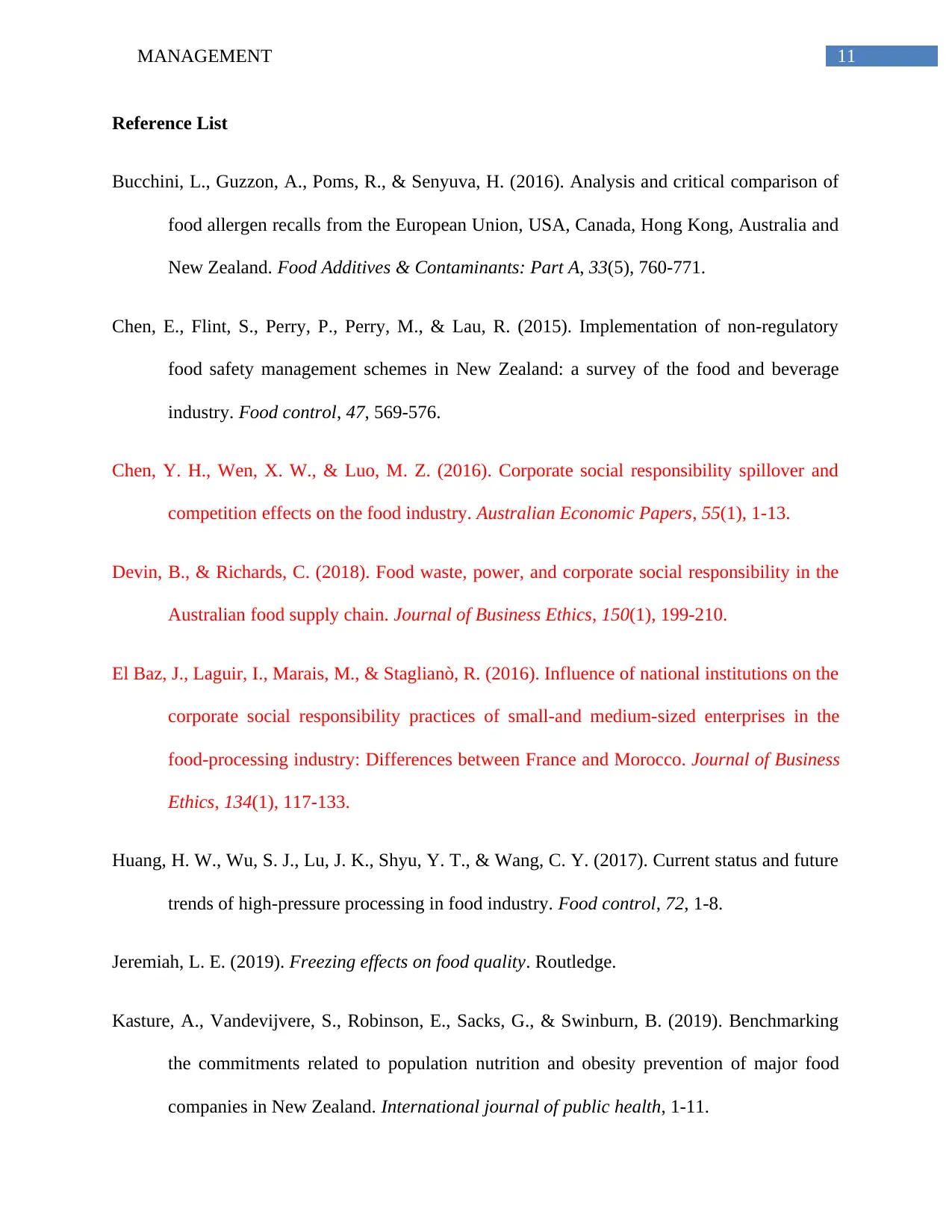
11MANAGEMENT
Reference List
Bucchini, L., Guzzon, A., Poms, R., & Senyuva, H. (2016). Analysis and critical comparison of
food allergen recalls from the European Union, USA, Canada, Hong Kong, Australia and
New Zealand. Food Additives & Contaminants: Part A, 33(5), 760-771.
Chen, E., Flint, S., Perry, P., Perry, M., & Lau, R. (2015). Implementation of non-regulatory
food safety management schemes in New Zealand: a survey of the food and beverage
industry. Food control, 47, 569-576.
Chen, Y. H., Wen, X. W., & Luo, M. Z. (2016). Corporate social responsibility spillover and
competition effects on the food industry. Australian Economic Papers, 55(1), 1-13.
Devin, B., & Richards, C. (2018). Food waste, power, and corporate social responsibility in the
Australian food supply chain. Journal of Business Ethics, 150(1), 199-210.
El Baz, J., Laguir, I., Marais, M., & Staglianò, R. (2016). Influence of national institutions on the
corporate social responsibility practices of small-and medium-sized enterprises in the
food-processing industry: Differences between France and Morocco. Journal of Business
Ethics, 134(1), 117-133.
Huang, H. W., Wu, S. J., Lu, J. K., Shyu, Y. T., & Wang, C. Y. (2017). Current status and future
trends of high-pressure processing in food industry. Food control, 72, 1-8.
Jeremiah, L. E. (2019). Freezing effects on food quality. Routledge.
Kasture, A., Vandevijvere, S., Robinson, E., Sacks, G., & Swinburn, B. (2019). Benchmarking
the commitments related to population nutrition and obesity prevention of major food
companies in New Zealand. International journal of public health, 1-11.
Reference List
Bucchini, L., Guzzon, A., Poms, R., & Senyuva, H. (2016). Analysis and critical comparison of
food allergen recalls from the European Union, USA, Canada, Hong Kong, Australia and
New Zealand. Food Additives & Contaminants: Part A, 33(5), 760-771.
Chen, E., Flint, S., Perry, P., Perry, M., & Lau, R. (2015). Implementation of non-regulatory
food safety management schemes in New Zealand: a survey of the food and beverage
industry. Food control, 47, 569-576.
Chen, Y. H., Wen, X. W., & Luo, M. Z. (2016). Corporate social responsibility spillover and
competition effects on the food industry. Australian Economic Papers, 55(1), 1-13.
Devin, B., & Richards, C. (2018). Food waste, power, and corporate social responsibility in the
Australian food supply chain. Journal of Business Ethics, 150(1), 199-210.
El Baz, J., Laguir, I., Marais, M., & Staglianò, R. (2016). Influence of national institutions on the
corporate social responsibility practices of small-and medium-sized enterprises in the
food-processing industry: Differences between France and Morocco. Journal of Business
Ethics, 134(1), 117-133.
Huang, H. W., Wu, S. J., Lu, J. K., Shyu, Y. T., & Wang, C. Y. (2017). Current status and future
trends of high-pressure processing in food industry. Food control, 72, 1-8.
Jeremiah, L. E. (2019). Freezing effects on food quality. Routledge.
Kasture, A., Vandevijvere, S., Robinson, E., Sacks, G., & Swinburn, B. (2019). Benchmarking
the commitments related to population nutrition and obesity prevention of major food
companies in New Zealand. International journal of public health, 1-11.
⊘ This is a preview!⊘
Do you want full access?
Subscribe today to unlock all pages.

Trusted by 1+ million students worldwide
1 out of 14
Related Documents
Your All-in-One AI-Powered Toolkit for Academic Success.
+13062052269
info@desklib.com
Available 24*7 on WhatsApp / Email
![[object Object]](/_next/static/media/star-bottom.7253800d.svg)
Unlock your academic potential
Copyright © 2020–2025 A2Z Services. All Rights Reserved. Developed and managed by ZUCOL.





